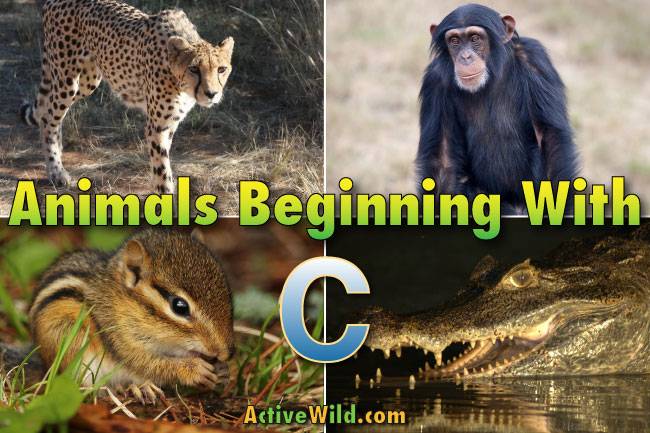
Animals that start with C include mammals such as the capybara, caribou and cheetah; birds such as cassowaries and cranes; reptiles such as cobras and crocodiles; and invertebrates such as the common octopus, cockroaches and cuttlefish.
On this page is a list containing these and many other interesting animals beginning with C, together with pictures and facts on each species.
Below each animal you’ll find links that you can follow for further information, pictures and videos.

Included in this list are individual species (e.g., the capybara) and groups of animals (e.g., caimans) whose names begin with C.
The scientific name and conservation status are provided for each of the individual species.
Index
Scroll down to see pictures and facts on all of the animals, or use the index below to go directly to a particular animal.
List Of Animals Beginning With C
- Caiman
- Caiman Lizard
- Camel Spider
- Cane Toad
- Capybara
- Caracal
- Caribou
- Cassowary
- Cat (Domestic)
- Catfish
- Chameleon
- Cheetah
- Chicken
- Chimpanzee
- Chinchilla
- Chinstrap Penguin
- Chipmunk
- Chital
- Clouded Leopard
- Cobra
- Cockroach
- Collared Peccary
- Common Octopus
- Cooper’s Hawk
- Cougar
- Coyote
- Coypu
- Crab
- Crab-Eating Fox
- Crabeater Seal
- Crane
- Crocodile
- Crow
- Cuttlefish
You can find animals beginning with other letters by clicking on the squares below…
Caiman
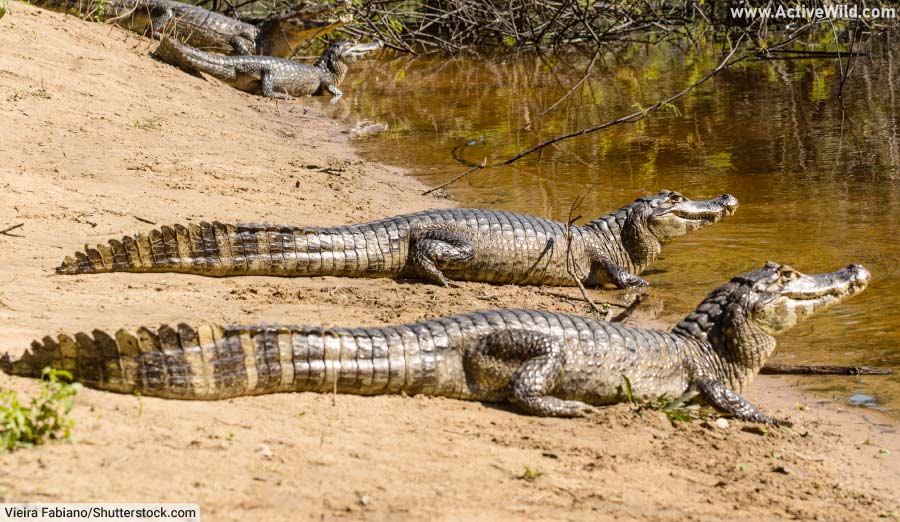
Type of animal: Reptile
Family: Alligatoridae
Where found: South America
Conservation status: see text
Caimans are crocodilian reptiles that inhabit the freshwater habitats of Central and South America.
Caimans are members of the Alligatoridae family, which is also home to the two species of alligator.
The six species of caimans, together with their scientific name and conservation status, are listed below:
- Spectacled caiman – Caiman crocodilus – Least Concern
- Yacare caiman – Caiman yacare – Least Concern
- Cuvier’s dwarf caiman – Paleosuchus palpebrosus – Least Concern
- Smooth-fronted caiman – Paleosuchus trigonatus – Least Concern
- Black caiman – Melanosuchus niger – Vulnerable
- Broad-snouted caiman – Caiman latirostris – Least Concern
The most common species is the spectacled caiman, a species named for the distinctive bony ridge, or “spectacle,” that runs between their eyes.
While most caimans are small to medium crocodilians, the largest, the black caiman, can grow up to 6 m (20 ft.) in length, making it the largest member of its family – bigger even than the American alligator.
Caimans are opportunistic predators, feeding on a variety of prey, including fish, birds, and mammals. They are formidable predators, equipped with powerful jaws and sharp teeth.
Caimans play an important role in their ecosystems as both predators and prey. Their presence helps to regulate populations of their prey species, and they also provide food for larger predators such as jaguars and anacondas.
Unfortunately, many caiman populations are threatened due to habitat loss and hunting for their meat and skin.
Discover More With Active Wild
You can find out more about caimans on this page: Caiman Facts
You can find out more about the spectacled caiman on this page: Spectacled Caiman Facts
Discover different types of reptiles on this page: Types of Reptiles
Caiman Lizard
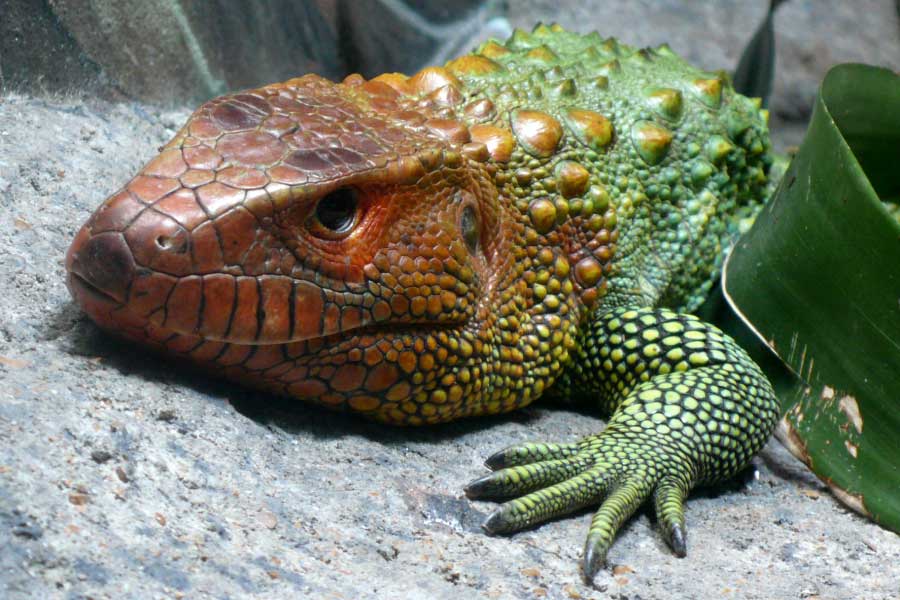
Type of animal: Reptile
Order: Squamata
Family: Teiidae
Genus: Dracaena
Where found: South America
Caiman lizards, genus Dracaena, are large, semiaquatic lizards native to the Amazon Basin of South America. They have rough, bumpy scales and a stout, muscular build. They are named for their resemblance to caimans.
There are two species of caiman lizard: the northern caiman lizard (Dracaena guianensis) and the Paraguay caiman lizard (Dracaena paraguayensis).
Caiman lizards are excellent swimmers and spend much of their time in the water. A transparent third eyelid known as a nictating membrane, protects their eyes as they dive. They propel themselves through the water with long, caiman-like tails.
Caiman lizards are also skilled climbers, using their sharp claws to grip onto branches and navigate their forest habitat.
Discover More With Active Wild
Discover different types of lizards on this page: Types of Lizards
Discover different types of reptiles on this page: Types of Reptiles
Camel Spider
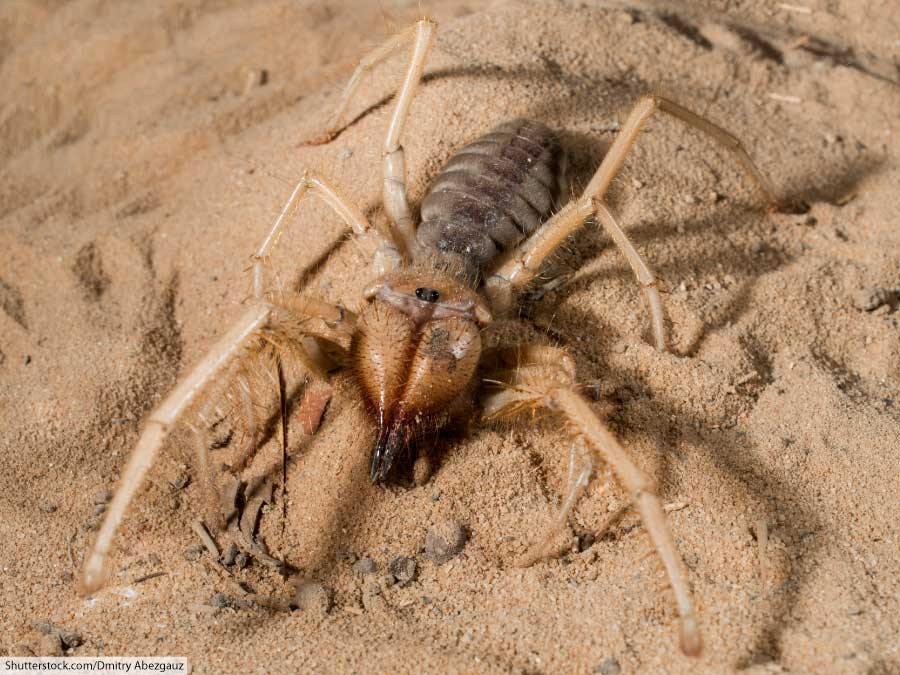
Type of animal: Arachnid
Order: Solifugae
Genus: Around 147 genera
Where found: Deserts worldwide except Australia and Antarctica
Camel spiders are also known as sun spiders, sun scorpions, and wind scorpions. Despite these names, camel spiders are neither true spiders nor true scorpions; they make up a separate group within Arachnida: the order Solifugae.
There are over 1,000 different species of camel spiders. These solitary, nocturnal hunters are typically brown in color to help them blend in their desert habitats.
The largest camel spiders reach lengths (including legs) of up to 15 cm / 6 in. Most species are considerably smaller.
Camel spiders are carnivores that eat a variety of prey animals. The diet of larger species even includes small vertebrates such as birds and lizards.
Unlike true spiders, camel spiders don’t spin webs and none are venomous.
Discover More With Active Wild
You can find out more about camel spiders on this page: Camel Spider Facts
You can find out more about arachnids on this page: Arachnids – The Ultimate Guide
Cane Toad
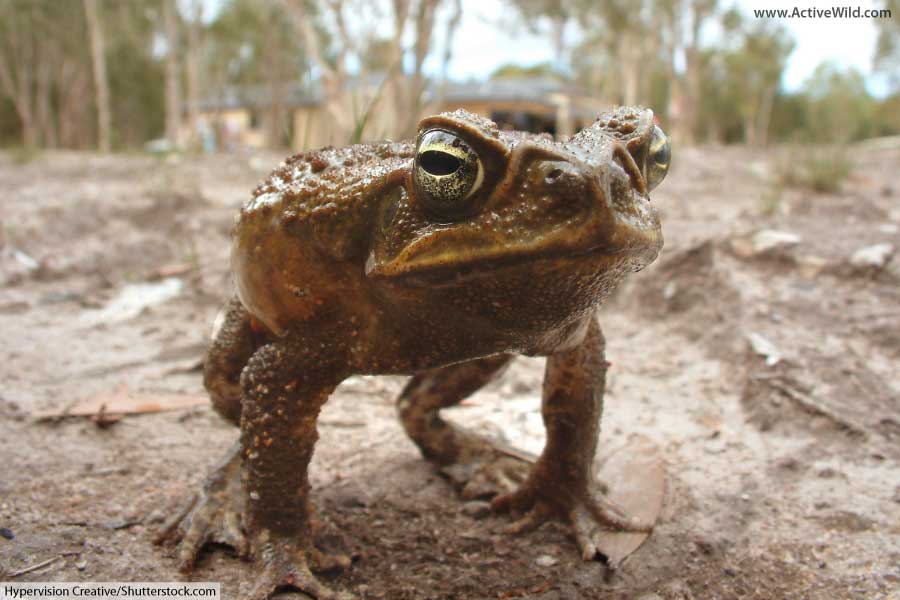
Scientific name: Rhinella marina
Type of animal: Amphibian
Family: Bufonidae
Where found: native to Central and South America, introduced elsewhere.
Conservation status: Least Concern
The Cane Toad is a large, heavily built toad species of toad native to Central and South America. It was introduced to other parts of the world, including Australia, to control agricultural pests, but has since become an invasive species causing harm to the local ecosystems.
Cane toads can grow up to 23 cm (9 inches) long and weigh over a kilogram (2.2 pounds). They have dry, warty skin and are gray, brown, or reddish-brown in color. Their toxin, which is secreted from glands on their backs, can be harmful or deadly to many predators, including humans, pets, and native wildlife.
Cane toads are considered a pest in many areas and efforts are underway to control their populations.
Discover More With Active Wild
You can find out more about cane toads on this page: Cane Toad Facts
You can find out more about amphibians on this page: Amphibians – The Ultimate Guide
Capybara
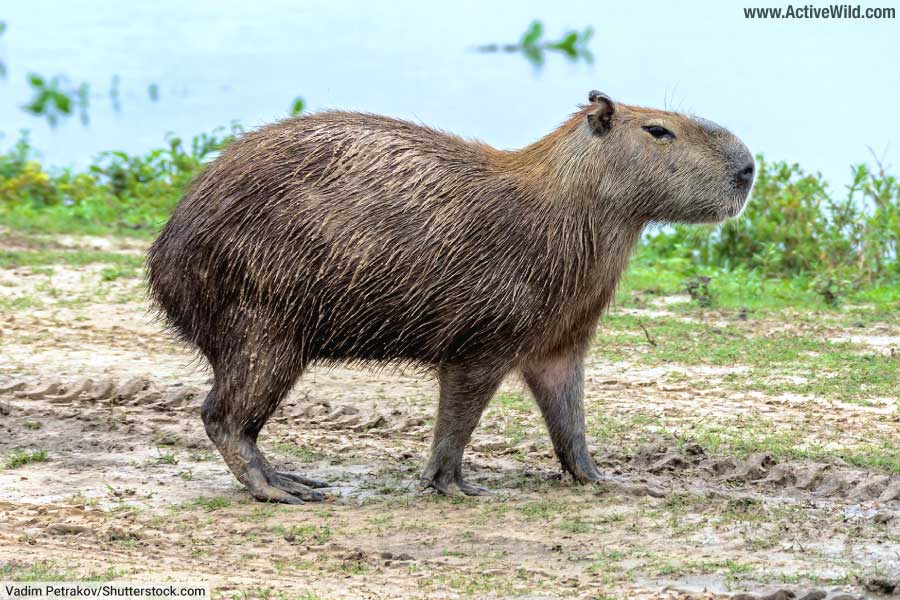
Scientific name: Hydrochoerus hydrochaeris
Type of animal: Mammal
Family: Caviidae
Where found: South America
Conservation status: Least Concern
The Capybara is the largest rodent in the world. These South American animals can grow up to 1.3 meters (4 feet) in length, weigh up to 66 kg (146 pounds), and have a life span of up to 8-10 years.
Capybaras are herbivores and feed on grasses and aquatic plants. They are semi-aquatic and spend a lot of their time in and around water, with their eyes, ears, and nostrils positioned on top of their head for easy detection of predators.
Capybaras are social animals and live in groups of up to 20 individuals. They are known for their docile nature and have become popular as pets in some parts of the world. However, in their native habitat, they are hunted for their meat and fur.
Discover More With Active Wild
You can find out more about capybaras on this page: Capybara Facts
You can see more South American animals on this page: South American Animals
Caracal

Scientific name: Caracal caracal
Type of animal: Mammal
Family: Felidae
Where found: Africa, Asia
Conservation status: Least Concern
The Caracal is a medium-sized wild cat found in Africa, Central Asia, and Southwest Asia. It is also known as the desert lynx or the Persian lynx, although it is not closely related to the true lynx species.
Caracals have reddish-brown fur and distinctive black tufted ears, which can be moved independently to help them detect prey. They are agile hunters, able to leap up to 3 meters (10 feet) in the air to catch birds in flight. Their diet consists of a variety of prey, including birds, rodents, and small ungulates.
Caracals are solitary animals and are mostly active at night. They are listed as a species of least concern by the International Union for Conservation of Nature (IUCN).
Discover More With Active Wild
You can find out more about the caracal on this page: Caracal Facts
You can see EVERY species of cat on this page: Wild Cats Species List with Pictures and Facts
Caribou
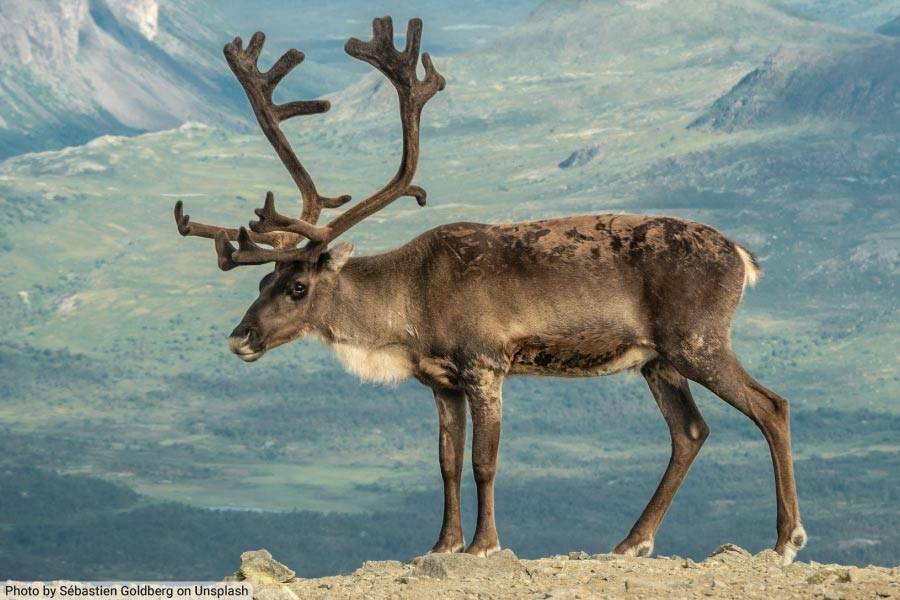
Scientific name: Rangifer tarandus
Type of animal: Mammal
Family: Cervidae
Where found: North America, Europe, Asia
Conservation status: Vulnerable
The Caribou is a species of deer that inhabits the Arctic and Subarctic regions of North America, Europe, and Asia. They are also known as reindeer in Eurasia, where they are domesticated and used for transportation, milk, and meat.
Caribou are well adapted to life in cold environments, with thick fur and broad hooves that help them travel over snow and ice. Both males and females have antlers, which are used by the males for competition and display during the mating season.
Caribou are herbivores, feeding on a variety of vegetation such as lichens, grasses, and mosses. They are also a critical source of food and resources for many indigenous peoples in the Arctic.
Climate change and habitat loss are among the main threats to caribou populations.
Discover More With Active Wild
You can find out more about caribou on this page: Caribou Facts
You can see more Arctic animals on this page: Arctic Animals
You can see more animals with antlers on this page: Animals With Antlers
Cassowary
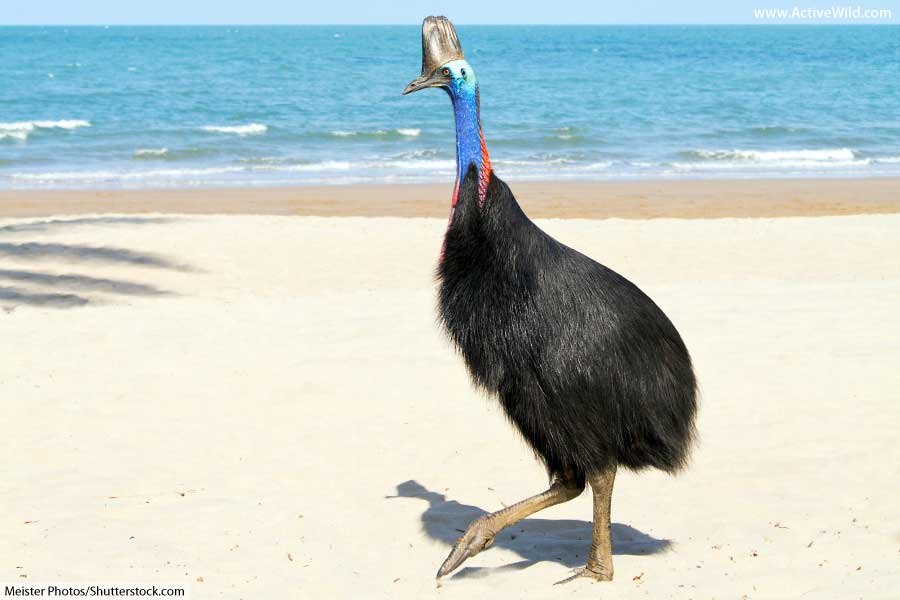
Type of animal: Bird
Family: Casuariidae
Where found: Asia, Australia
Cassowaries are large, flightless birds found in the tropical rainforests of Australia, Papua New Guinea, and some neighboring islands. There are three species of cassowary: the Southern Cassowary, the Dwarf Cassowary, and the Northern Cassowary. Only the southern cassowary is found in Australia.
Cassowaries have a distinctive appearance, with a tall crest on their head, a bright blue neck, and a long, sharp claw on their inner toe. The southern cassowary is the world’s third largest species of bird (after the two ostrich species).
The three species are listed below with their scientific name and IUCN conservation status:
- Southern Cassowary, Casuarius casuarius, Vulnerable
- Dwarf Cassowary, Casuarius bennetti, Near Threatened
- Northern Cassowary, Casuarius unappendiculatus, Endangered
Cassowaries are known for their aggressive behavior and powerful kicks, which they use for self-defense and to establish dominance. They are important seed dispersers, consuming a variety of fruits and berries in their diet.
Discover More With Active Wild
You can find out more about cassowaries on this page: Cassowary Facts
You can find out more about birds on this page: Birds – The Ultimate Guide
Discover different types of birds on this page: Types of Birds
Cat (Domestic)
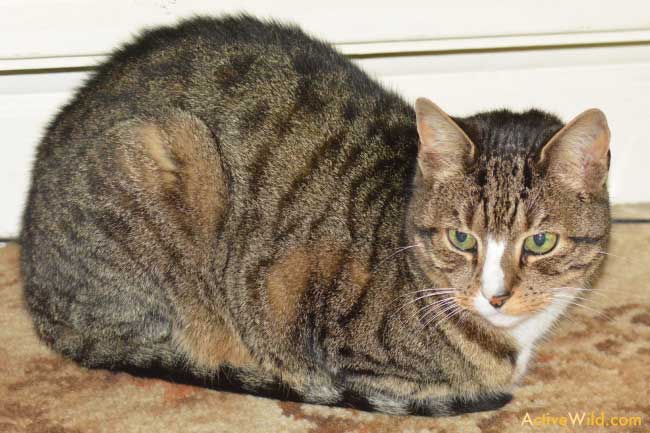
Scientific name: Felis catus
Type of animal: Mammal
Family: Felidae
Where found: Worldwide
Conservation status: Domestic
The Domestic Cat is a small carnivorous mammal thought to have been domesticated around 7,500 years ago.
Cats have a wide variety of coat colors and patterns, and can have short, medium, or long fur. There are around 60 “official” cat breeds, including Persian, Siamese and Burmese. Cats are popular pets and are known for their playful, affectionate, and sometimes independent nature.
Domestic cats are skilled hunters, capable of catching and killing small prey such as rodents and birds. Cat owners are often presented with prey items as “gifts” from their pets.
In many cultures, cats are considered symbols of good luck, wisdom, and companionship.
Domestic cats are able to breed with wildcats, which is a threat to wildcat populations.
Discover More With Active Wild
Discover more about cats on this page: Fun Facts On Cats
You can see EVERY species of cat on this page: Wild Cats Species List with Pictures and Facts
Catfish
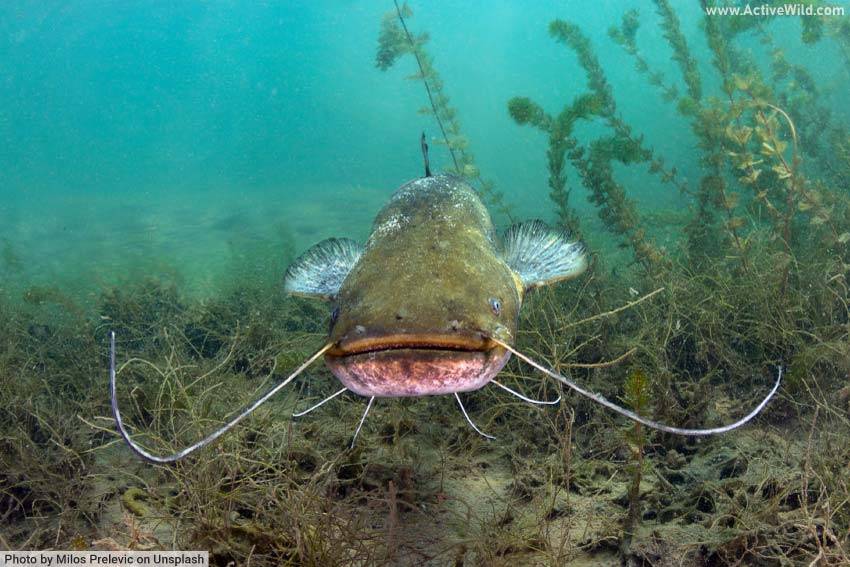
Type of animal: Fish
Order: Siluriformes
Family: Over 35 different families
Genus: Over 412 genera
Where found: All continents except Antarctica
Catfish are an order (Siluriformes) of fish, so-named due to the resemblance of their long feelers, or “barbels” to a cat’s whiskers. All catfish species have at least one pair of long barbels. The fish use these sensitive appendages to find food.
There are around 3,000 different catfish species; most are freshwater fish, but a few members of the families Ariidae and Plotosidae are found in marine habitats.
Catfish species vary greatly in size, with the smallest, the dwarf corydoras, reaching a length of around 4 cm / 1.6 in.; and the largest, the wels catfish, reaching a length of up to 4.5 m / 15 feet.
Some catfish species are equipped with venomous spines. Although catfish are not usually a threat to humans, the venom of the stripped eel catfish has caused a small number of fatalities.
Discover More With Active Wild
You can find out more about fish on this page: Fish – The Ultimate Guide
Discover different types of fish on this page: Types of Fish
Chameleon
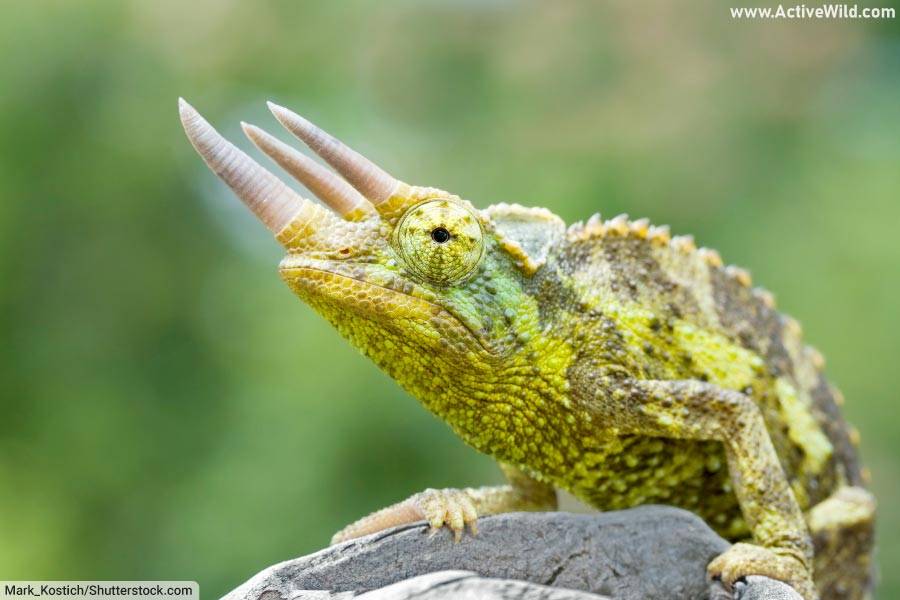
Type of animal: Reptiles
Order: Squamata
Family: Chamaeleonidae
Genera: Bradypodion, Brookesia, Chamaeleo, and Rhampoleon
Where found: Africa and Asia
Chameleons are a family (Chamaeleonidae) of lizards widely known for their ability to change the color of their skin.
It was previously believed that chameleons only changed colors to match their background for camouflage, but it is now known that color-changing is also used to regulate body temperature and to communicate mood.
The chameleon’s color changes when strips of nanocrystals on one of the top layers of their skin are rearranged.
Chameleons are insectivores (insect-eaters). They catch their prey with incredible precision using their projectile, sticky tongues, which are around twice the length of their bodies.
Chameleons have binocular vision and eyes that can move independently, providing the lizards with 360-degree vision.
There are 222 species of chameleon (source). The smallest is the nano chameleon. With a length of just 13.5 mm / 0.53 in., it’s also the world’s smallest known reptile.
The largest chameleon is Parson’s chameleon, which reaches 70 cm / 28 in. in length.
Discover More With Active Wild
Discover different types of lizards on this page: Types of Lizards
Discover different types of reptiles on this page: Types of Reptiles
Cheetah

Scientific name: Acinonyx jubatus
Type of animal: Mammal
Family: Felidae
Where found: Africa, Asia
Conservation status: Vulnerable
No list of animals that start with C would be complete without the Cheetah. This large, slender, and exceptionally fast wild cat is found in various parts of Africa and a small population in Iran. It is the world’s fastest land animal, capable of reaching speeds of up to 70 miles per hour (112 kilometers per hour) in just a few seconds.
Cheetahs have distinctive spotted fur, a small head, dark, “tear-like” facial markings, long legs, and a slender, aerodynamic body. They are solitary hunters and feed primarily on small antelopes such as gazelles and impalas.
Due to habitat loss, poaching, and other threats, cheetahs are listed as vulnerable on the International Union for Conservation of Nature (IUCN) Red List of Threatened Species.
Discover More With Active Wild
You can find out more about cheetahs on this page: Cheetah Facts
You can see EVERY species of cat on this page: Wild Cats Species List with Pictures and Facts
Chicken

Scientific name: Gallus gallus domesticus
Type of animal: Bird
Family: Phasianidae
Where found: worldwide
Conservation status: Domestic
The Domestic Chicken is a domesticated member of the pheasant family that is one of the most common and widespread domestic animals in the world. It is kept for its meat, eggs, and feathers, and found on farms and in households around the globe. The species has been selectively bred over thousands of years for specific traits, such as size, egg production, and meat quality.
Chickens have a variety of feather colors and patterns, depending on the breed. They are highly social animals, forming groups or “flocks” that establish a hierarchy.
Chickens are omnivores and have a varied diet that includes seeds, insects, and other small animals. The welfare of domestic chickens is a cause of concern for animal welfare organizations.
Discover More With Active Wild
You can find out more about birds on this page: Birds – The Ultimate Guide
Discover different types of birds on this page: Types of Birds
Chimpanzee

Scientific name: Pan troglodytes
Type of animal: Mammal
Family: Hominidae
Where found: Africa
Conservation status: Endangered
The Chimpanzee is a highly intelligent and social primate that is native to the forests of central and western Africa. It is one of the closest living relatives to humans, sharing approximately 98% of our DNA.
Chimpanzees have dark fur and a prominent brow ridge, and are known for their expressive faces and vocalizations. They live in groups or communities of up to several dozen individuals, using complex communication and social behavior in their relationships with other group members.
Chimpanzees are omnivores, feeding on a variety of plant and animal foods, including fruits, leaves, insects, and occasionally small mammals. Chimpanzee populations are threatened by habitat loss, poaching, and disease.
Discover More With Active Wild
You can find out more about chimpanzees on this page: Chimpanzee Facts
You can find out more about primates on this page: Primates – Ultimate Guide
Chinchilla
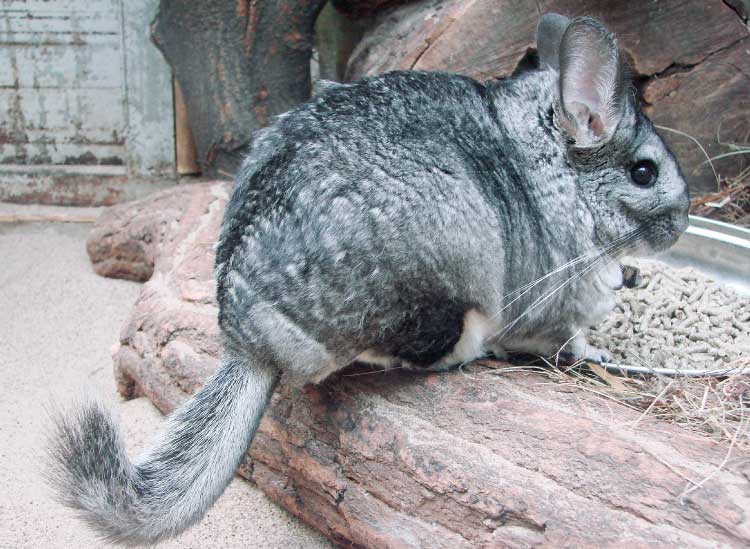
Type of animal: Mammal
Order: Rodentia
Family: Chinchillidae
Genus: Chinchilla
Where found: South America
Conservation status: Endangered
Chinchillas are medium-sized rodents that were once hunted until near extinction because of their soft, thick grey fur. They have long, rounded ears, big eyes, bushy tails, and a lighter underside.
There are two species of chinchilla: the long-tailed chinchilla (Chinchilla chinchilla), also known as Andean Chinchilla; and the short-tailed chinchilla (Chinchilla lanigera). Both species are assessed as “endangered” by the IUCN and their populations are decreasing.
Chinchillas inhabit the rocky Andes Mountains at elevations as high as 800 m / 2,625 feet. They are nocturnal herbivores that spend the day resting in rocky caves before emerging at sunset to forage.
Although increasingly scarce in the wild, chinchillas are bred in captivity and commonly sold as pets.
Discover More With Active Wild
You can find out more about rodents on this page: Rodents – The Ultimate Guide
You can see more South American animals on this page: South American Animals
Chinstrap Penguin
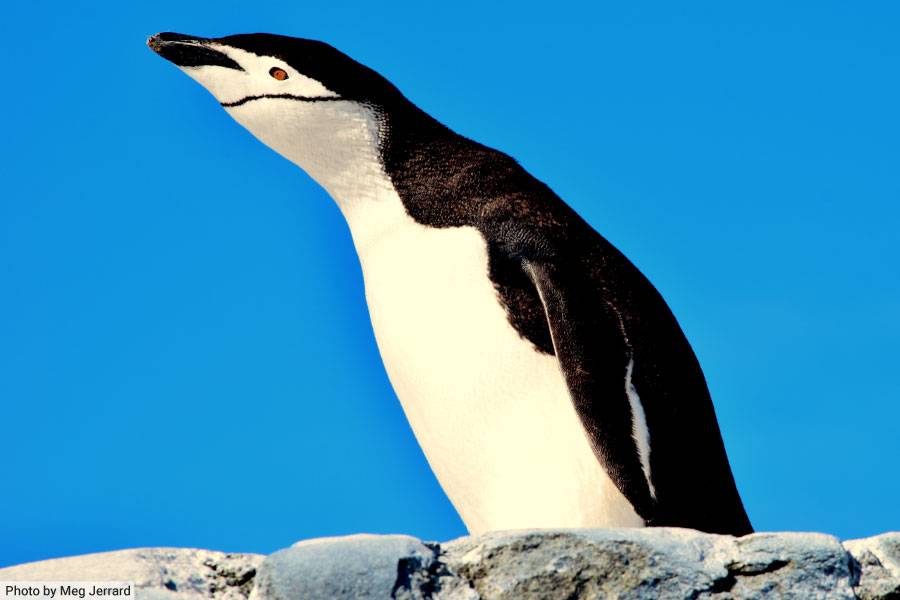
Scientific name: Pygoscelis antarcticus
Type of animal: Bird
Animal family: Spheniscidae
Where found: Antarctica
Conservation status: Least Concern
The Chinstrap Penguin is a species of penguin that inhabits the southern waters of the Antarctic. It is easily recognizable by the thin black line that runs under its chin, from which it gets its name.
The chinstrap is a small to medium-sized penguin, standing at around 70 cm (28 inches) tall and weighing between 3.2 to 6.5 kg (7.1 to 14.3 lb.).
Chinstrap penguins are excellent swimmers and divers, using their powerful flippers and streamlined bodies to propel themselves through the water in search of prey, such as small fish, krill and squid. They are able to withstand the harsh conditions of the Antarctic with a thick layer of feathers and blubber for insulation.
During the breeding season, Chinstrap Penguins gather in large colonies on rocky beaches or cliff faces, where they build nests out of stones and pebbles. They lay two eggs per breeding season, and both parents take turns incubating the eggs and caring for the chicks.
The chinstrap is the most numerous of all penguin species, with a population consisting of an estimated 8,000,000 mature individuals.
Although the chinstrap penguin can live up to 20 years old, due to predation, its life expectancy in the wild is much lower. Its main predators are leopard seals, sea lions, and sharks. Its eggs are preyed on by skuas.
Discover More With Active Wild
You can see pictures and read facts on EVERY species of penguin on this page: Types Of Penguins
Chipmunk
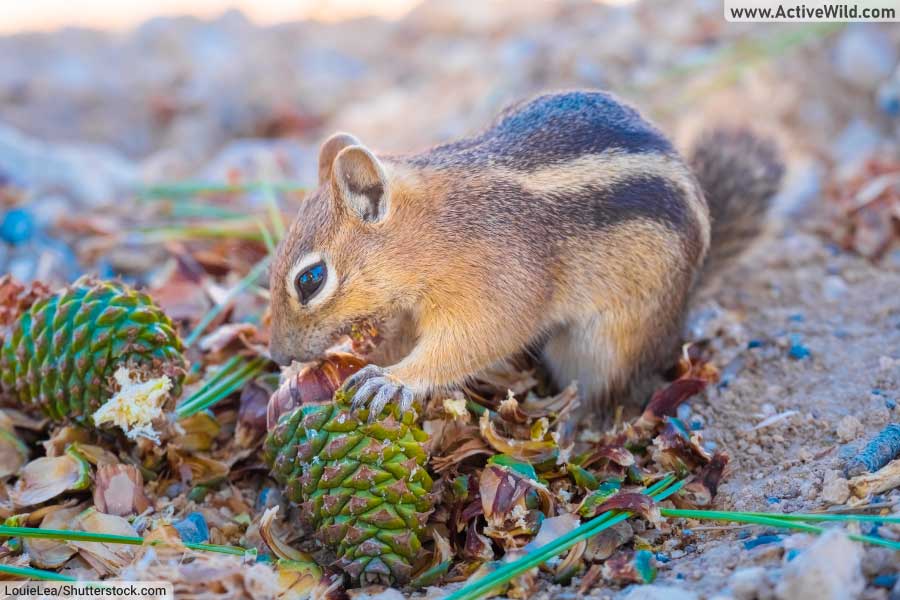
Type of animal: Mammal
Family: Sciuridae
Where found: North America, Asia
Chipmunks are small, striped rodents belonging to the squirrel family, Sciuridae. Only one of the 24 species of chipmunk is found outside of North America: the Siberian chipmunk is found from Central Russia to Japan and China.
Chipmunks have short, soft fur, and distinctive stripes along their back and face, which helps to distinguish them from other rodents.
Chipmunks are diurnal (active during the day) and are known for their quick movements and acrobatic abilities. They have a varied diet that includes seeds, nuts, berries, and insects, and are known for storing food in their cheek pouches to take back to their burrows. Chipmunks are also known for their high-pitched vocalizations, which they use to communicate with one another. While they can be considered pests in some areas, chipmunks are an important part of many ecosystems, and provide food for predators such as birds of prey and snakes.
Discover More With Active Wild
You can find out more about rodents on this page: Rodents – The Ultimate Guide
You can see more North American animals on this page: North American Animals
Chital (Spotted Deer)
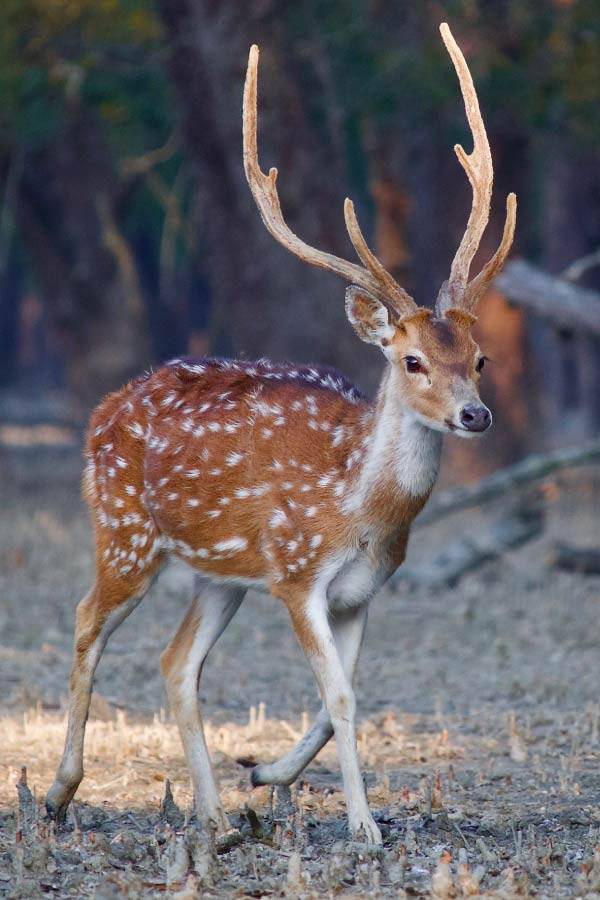
Scientific name: Axis axis
Type of animal: Mammal
Family: Cervidae
Where found: Asia
Conservation status: Least Concern
The Chital, also known as the spotted deer, is a species of deer found in the Indian subcontinent and Sri Lanka. It has a distinctive coat pattern, with white spots on a reddish-brown coat.
The chital is a medium-sized deer, with males weighing up to 90 kilograms and females up to 50 kilograms. An herbivore, it feeds primarily on grasses, leaves, and fruits.
Chitals are social animals and live in herds that range in size from a few individuals to several dozen. They are preyed upon by tigers, leopards, and other large carnivores, and use their agility and speed to avoid predation.
Discover More With Active Wild
You can see more Asian animals on this page: Asian Animals
You can see more animals with antlers on this page: Animals With Antlers
Clouded Leopard
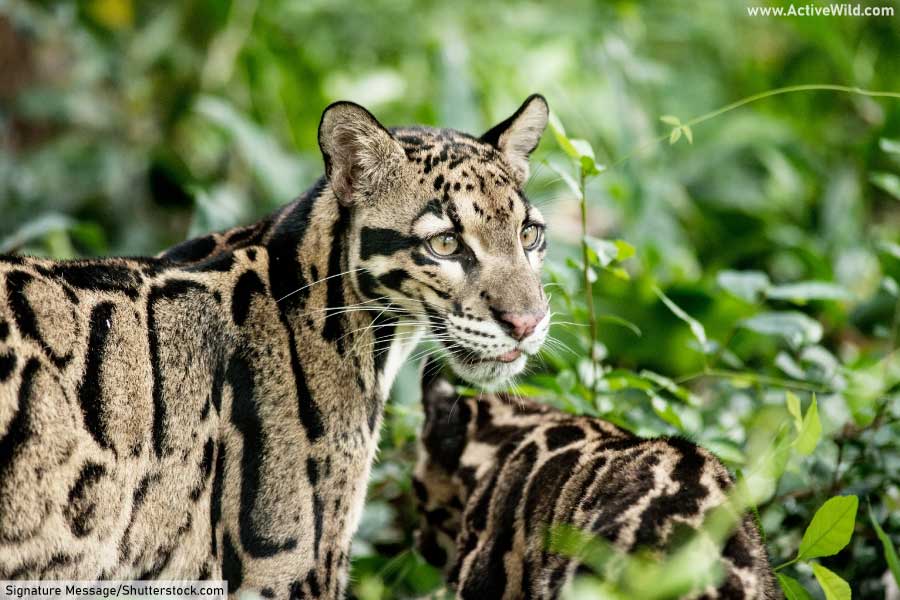
Scientific name: Neofelis nebulosa
Type of animal: Mammal
Family: Felidae
Where found: Asia
Conservation status: Vulnerable
The Clouded Leopard is a medium-sized wild cat found in the forests of Southeast Asia and parts of China. It has a distinctive coat pattern, with large cloud-like spots on a tan or grayish-brown background.
Clouded leopards are arboreal, meaning they spend much of their time in trees, where they hunt prey such as birds and small mammals. They are powerful climbers and able to hang from branches using their long tail, which is almost as long as their body.
Clouded leopards are solitary and elusive animals, making them difficult to study in the wild. They are listed as vulnerable on the IUCN Red List of Threatened Species due to habitat loss and poaching for their fur and body parts.
Discover More With Active Wild
You can find out more about clouded leopards on this page: Clouded Leopard Facts
You can see EVERY species of cat on this page: Wild Cats Species List with Pictures and Facts
Cobra
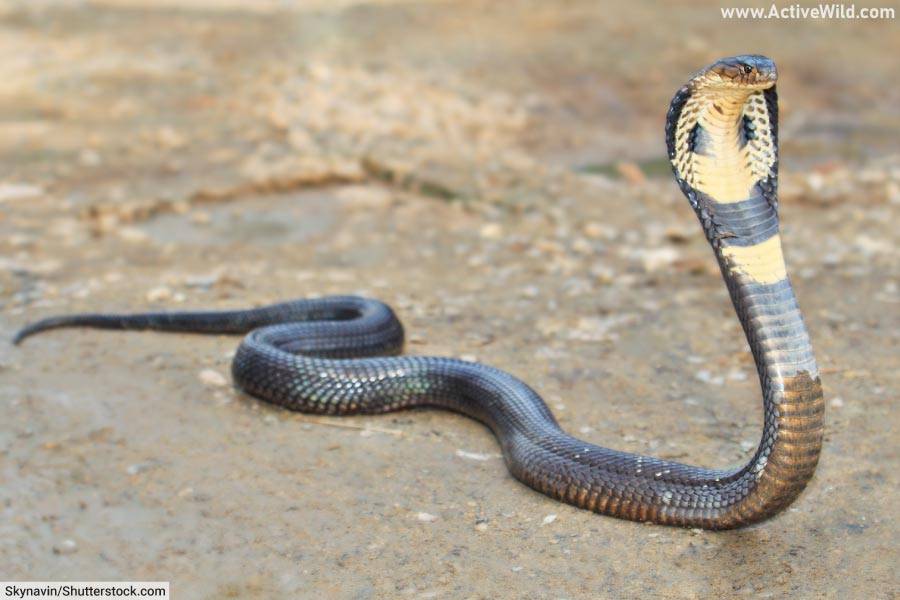
Type of animal: Reptile
Order: Squamata
Family: Elapidae
Genus: Naja and Ophiophagus
Where found: Africa and Asia
Cobras are a group of venomous snakes belonging to the family Elapidae. They are native to various parts of Africa and Asia, and are known for their distinctive hood, which they expand when threatened or alarmed. The hood is formed by the extension of the ribs behind the snake’s head, and serves as a warning to potential predators.
There are around 38 species of cobras, including the Indian cobra, the Egyptian cobra, and the king cobra. The king cobra is the largest venomous snake in the world, reaching lengths of up to 19 ft. / 5.79 m. Cobras primarily feed on rodents, birds, and other snakes, and use their venom to immobilize their prey.
Despite their potentially deadly venom, cobras are often revered in many cultures and are featured prominently in mythology and folklore.
Discover More With Active Wild
You can find out more about snakes on this page: Snake Facts
Discover different types of snakes on this page: Types of Snakes
Cockroach
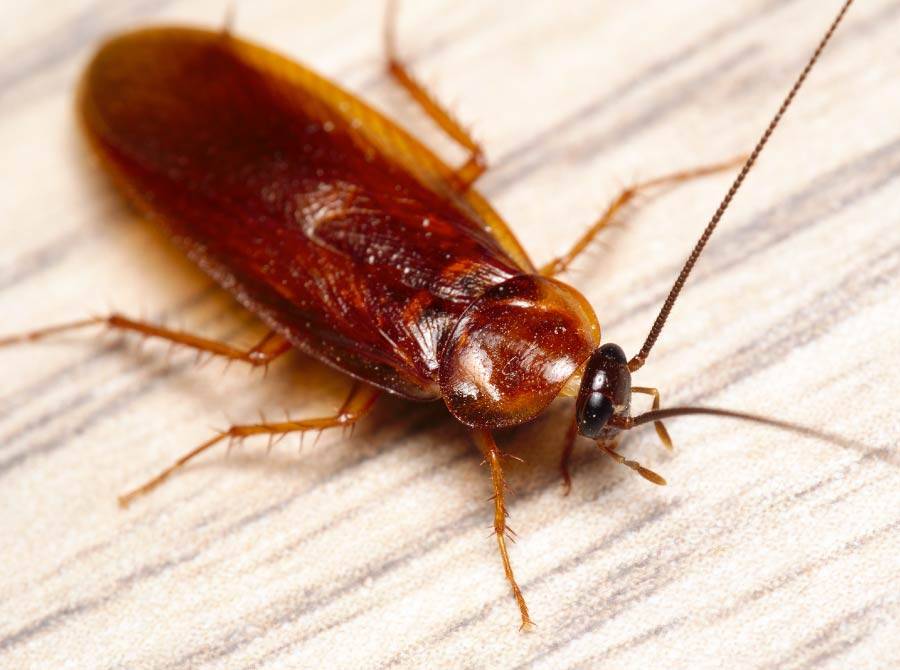
Type of animal: Insect
Order: Blattodea
Where found: Worldwide
Cockroaches are insects that have been around since the age of dinosaurs. They have flat, oval-shaped bodies, and long antennae and legs. Cockroaches are known for their ability to survive in a variety of environments and can feed on almost anything, including food scraps, paper, and even soap. They are nocturnal insects and can move quickly, making them difficult to catch.
Cockroaches can be a nuisance in households and can carry diseases, and their droppings and body parts can trigger allergies and asthma in some people.
There are many species of cockroaches, but the most common ones found in households include the German cockroach, American cockroach, and Oriental cockroach. Pest control measures, such as cleaning and sealing food sources, using baits and traps, and chemical treatments, can help manage cockroach infestations.
True survivors, some cockroach species can live for up to a month without food, and can survive radiation doses up to 15x larger than the lethal dose for a human.
Discover More With Active Wild
You can find out more about insects on this page: Insects – The Ultimate Guide
Discover more invertebrates on this page: List Of Invertebrates
Collared Peccary

Scientific name: Pecari tajacu
Type of animal: Mammal
Animal family: Tayassuidae
Where found: South America, Central America, and North America
Conservation status: Least Concern
The Collared Peccary, also known as the Javelina (on behalf of its razor-sharp tusks), is a species of pig-like, hoofed mammal found in parts of North, Central, and South America. It is small to medium-sized, standing at around 50 to 60 cm (20 to 24 inches) tall and weighing between 16 to 40 kg (35 to 88 lb).
Collared Peccaries are easily recognizable by the white band of hair that runs across their shoulders and around their neck, hence their name. They are social animals, often living in herds of up to 20 individuals, and being highly vocal. They have keen senses of smell and hearing, but extremely poor eyesight.
These animals are omnivores, feeding on a variety of plant and animal matter, including fruits, roots, insects, and small vertebrates. They are also known for their strong jaws and sharp tusks, which they use for defense against predators and during dominance displays.
Collared Peccaries are adaptable and can be found in a variety of habitats, including deserts, forests, and grasslands. Despite being relatively common and widespread, habitat loss and hunting are major threats to their populations in some areas.
Collared Peccaries are important components of many ecosystems, playing a vital role in seed dispersal and serving as prey for larger predators.
Discover More With Active Wild
You can find out more about mammals on this page: Mammals – The Ultimate Guide
Discover different types of mammals on this page: Types of Mammals
Common Octopus
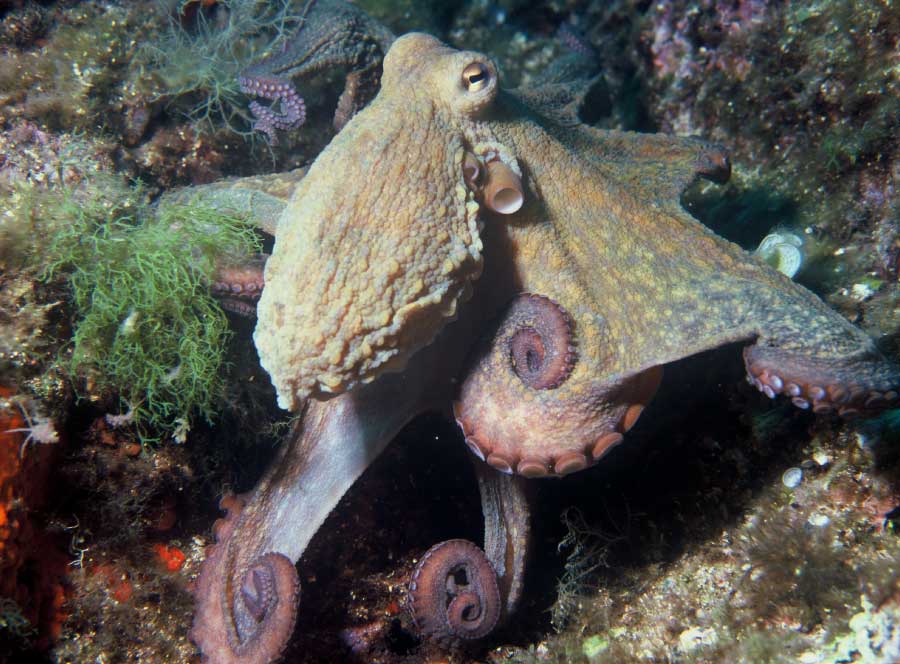
Scientific name: Octopus vulgaris
Type of animal: Mollusk
Family: Octopodidae
Where found: Oceans worldwide
Conservation status: Least Concern
The Common Octopus is a cephalopod mollusk found in temperate and tropical oceans around the world. It has a soft body and eight long, sucker-covered arms which are used to grasp and manipulate objects. It is able to regrow lost limbs.
The Common Octopus is known for its ability to change its skin color and texture to blend in with its surroundings or to communicate with other octopuses.
Common Octopuses are carnivorous and feed on a variety of prey, including crabs, shrimp, and fish. They are solitary animals and are typically active at night. They have a short lifespan of only around one to two years.
Discover More With Active Wild
You can find out more about common octopuses on this page: Common Octopus Facts
Discover different types of mollusks on this page: Mollusks Examples
Cooper’s Hawk

Scientific name: Accipiter cooperii
Type of animal: Bird
Animal family: Accipitridae
Where found: North America and Central America
Conservation status: Least Concern
Cooper’s Hawk is a medium-sized bird of prey native to North America. It belongs to the family Accipitridae, which includes hawks, eagles, and other raptors. Cooper’s Hawk is known for its agile flight and sharp talons, both of which are adaptions for catching small to mid-sized birds, its primary prey. The agile hawk will also target small mammals and reptiles.
This hawk has a distinctive appearance, with a long, banded tail and a rounded, bluish-gray head. The adult male is smaller than the female and has a slate-gray back, while the female has a brown back. Juvenile Cooper’s Hawks have a brownish coloration with streaked underparts.
Cooper’s Hawk can be found in a variety of habitats, including forests, woodlands, and urban areas. They are known for their adaptability and have been observed nesting in backyards and city parks.
Although once heavily persecuted, Cooper’s Hawk has rebounded in recent decades due to conservation efforts. The species is now a common sight in many parts of its range and serves as an important indicator species for the health of forest and woodland ecosystems.
Discover More With Active Wild
You can find out more about birds on this page: Birds – The Ultimate Guide
Discover different types of birds on this page: Types of Birds
Cougar
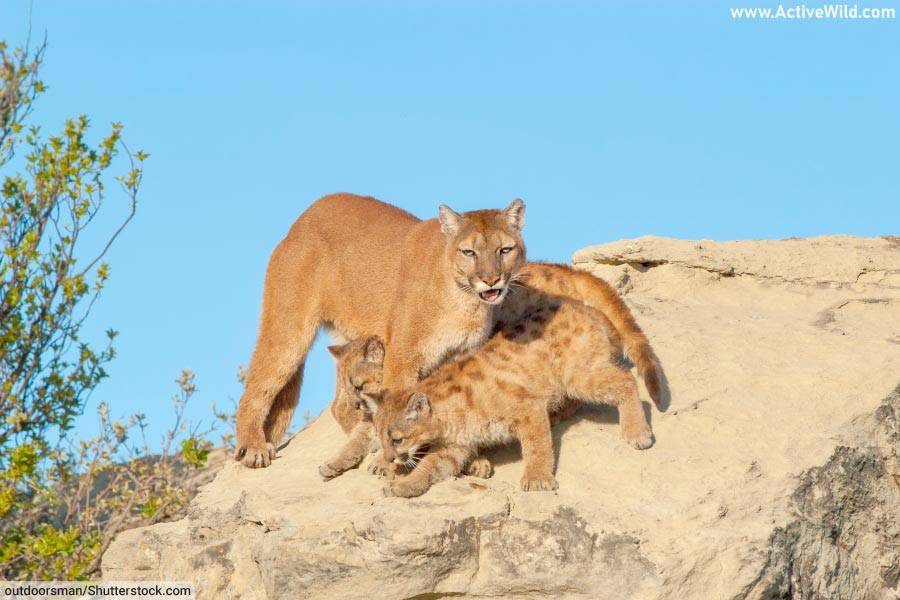
Scientific name: Puma concolor
Type of animal: Mammal
Family: Felidae
Where found: North America, South America
Conservation status: Least Concern
The cougar, also known as the mountain lion or puma, is a large wild cat native to the Americas. Cougars are solitary and territorial animals and are found in a variety of habitats, including forests, deserts, and grasslands. They have a tan or reddish-brown coat, with black spots on their legs and tail, and are known for their muscular build and powerful legs. Cougars are carnivores that prey on a variety of animals, their favored prey being large, hooved animals such as deer, goats and sheep.
With the largest hind legs in proportion to body size of all cats, the cougar is able to jump up to 20 feet / 6.1 m in a single leap.
Discover More With Active Wild
You can find out more about the cougar on this page: Cougar Facts
You can see EVERY species of cat on this page: Wild Cats Species List with Pictures and Facts
Coyote

Scientific name: Canis latrans
Type of animal: Mammal
Family: Canidae
Where found: North America
Conservation status: Least Concern
The coyote is a species of wild dog native to North America. It is an adaptable animal, found in a variety of habitats, including forests, grasslands, deserts, and even urban areas.
Coyotes have a gray or brown coat with a white underbelly and a bushy tail. It is an omnivore whose diet includes small mammals, birds, insects, and fruits.
The species, whose scientific name Canis latrans means “barking dog”, is known for its distinctive yipping and howling calls, which are used for communication and to establish territory.
Coyotes are social animals that live in family groups called packs. Coyotes can pose a threat to livestock and pets and are sometimes hunted as a result. However, they play an important role in their ecosystems by controlling populations of small mammals and birds.
The coyote has been able to thrive despite habitat loss and fragmentation caused by human activity. It is closely related to the wolf, and is more likely to be found living in proximity to humans than its larger cousin.
Discover More With Active Wild
You can find out more about coyotes on this page: Coyote Facts
You can see EVERY species of dog on this page: Wild Dog Species List with Pictures and Facts
Coypu

Scientific name: Myocastor coypus
Type of animal: Mammal
Family: Echimyidae
Where found: native to South America, introduced elsewhere
Conservation status: Least Concern
The coypu, also known as the nutria, is a large semi-aquatic rodent native to South America but which has been introduced to other parts of the world for fur farming.
Coypus have a brown fur coat, webbed hind feet, and a long, cylindrical tail. They are excellent swimmers and can stay submerged for up to five minutes.
Coypus are herbivores and feed on a variety of aquatic plants and roots. They are considered pests in many areas where they have been introduced due to their destructive impact on wetlands, riverbanks, and agricultural crops. Coypus are also carriers of diseases that can affect humans and other animals.
Efforts are being made to control their populations in these areas through trapping and other methods. However, coypus are still raised for their fur in some regions.
Discover More With Active Wild
You can find out more about rodents on this page: Rodents – The Ultimate Guide
You can see more South American animals on this page: South American Animals
Crab
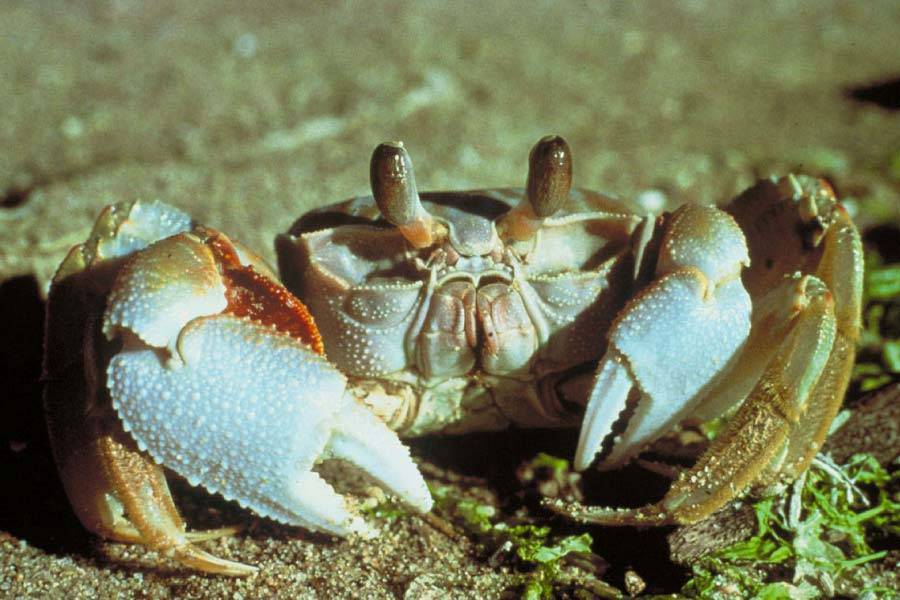
Type of animal: Crustacean
Infraorder: Brachyura
Where found: worldwide
Crabs are crustaceans belonging to the infraorder Brachyura. Crabs have hard exoskeletons, and ten legs, the first pair of which are equipped with pincers.
Crabs range in size from the tiny pea crab, Pinnotheres pisum, to the Japanese spider crab, whose leg span can be up to 4 meters (13 ft.) across.
The majority of the 7,762 recognized crab species (source) live in the sea, but around 850 species live in freshwater habitats. A small number of crabs live on land.
Crabs are scavengers and opportunistic predators, feeding on a variety of small animals, plants, and decaying matter. Crabs have adapted to their environments in a variety of ways, such as by having camouflage coloration to blend in with their surroundings or by having specialized appendages for digging, climbing, or swimming. Some crabs are also able to regenerate lost limbs.
Crabs are an important part of many marine ecosystems, providing food for larger predators and helping to control populations of other animals.
Discover More With Active Wild
You can find out more about crustaceans on this page: Crustaceans – The Ultimate Guide
Discover more invertebrates on this page: List Of Invertebrates
Crab-Eating Fox
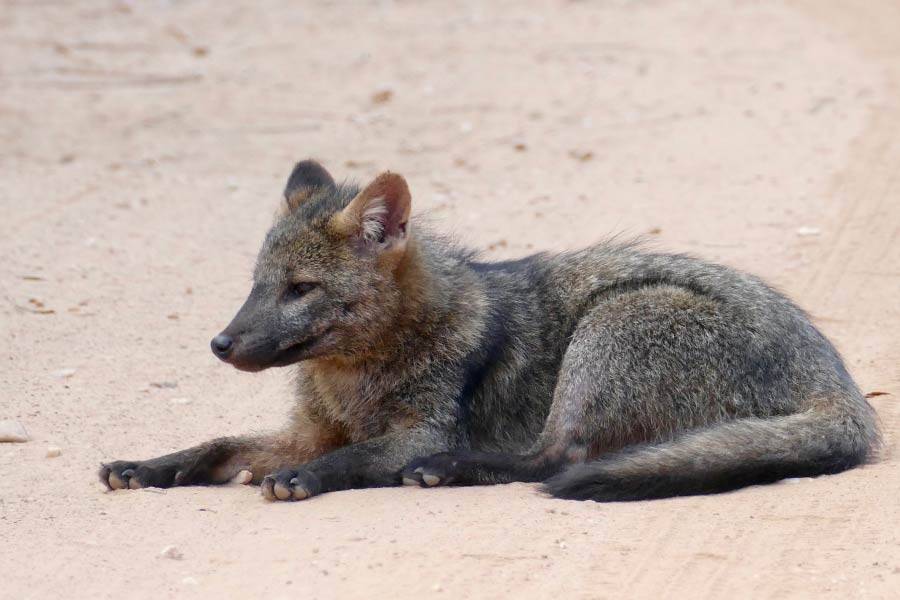
Scientific name: Cerdocyon thous
Type of animal: Mammal
Family: Canidae
Where found: Central and South America
Conservation status: Least Concern
The crab-eating fox is a small canid (member of the dog family, Canidae) found in Central and South America. It has a gray-brown coat, pointed ears, and a bushy tail.
The crab-eating fox is omnivorous. Although it does not exclusively eat crabs, the crustaceans do form a major part of its diet during the wet season. It will also eat a variety of small animals, fruits, and insects.
The crab-eating fox is primarily nocturnal. It lives in small groups consisting of a dominant pair and their offspring. The species is adaptable and can be found in a variety of habitats, including forests, grasslands, and even urban areas.
Discover More With Active Wild
You can see EVERY species of dog on this page: Wild Dog Species List with Pictures and Facts
Crabeater Seal
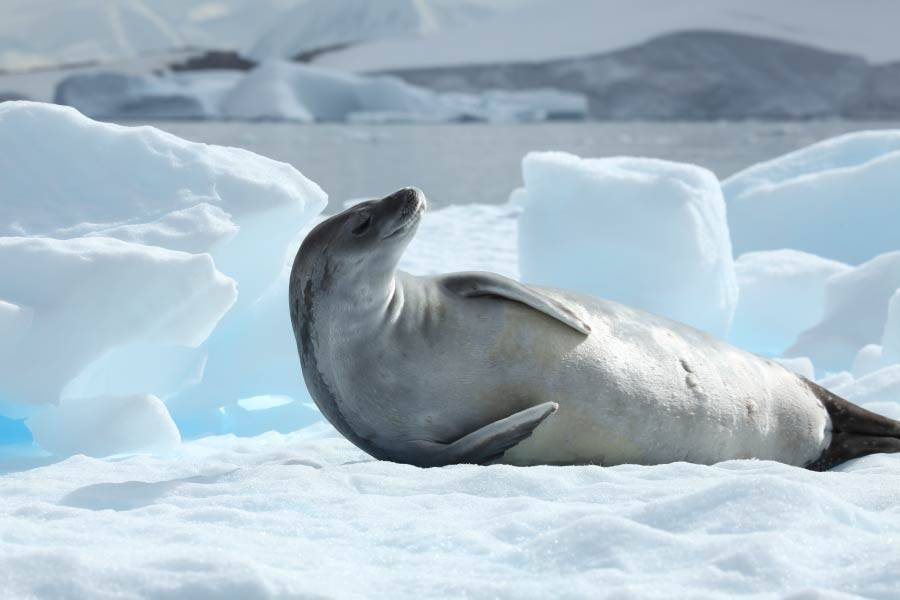
Scientific name: Lobodon carcinophaga
Type of animal: Mammal
Family: Phocidae
Where found: Antarctica
Conservation status: Least Concern
The crabeater seal is a species of seal found primarily on the Antarctic pack ice. Despite its name, the crabeater seal does not eat crabs, but instead feeds primarily on another type of crustacean: the Antarctic krill. It will also feed on small fish and squid.
The crabeater seal has a silver-gray coat with dark spots and can weigh up to 500 lb / 226.8 kg.
Crabeater seals are excellent swimmers and divers, capable of staying underwater for up to 15 minutes at a time. The world’s most abundant seal, the crabeater a social animal that forms large colonies sometimes consisting of several thousand individuals.
Crabeater seals are an important part of the Antarctic food chain, serving as prey for larger predators such as killer whales and leopard seals. While their populations are relatively stable, crabeater seals are vulnerable to habitat loss and climate change as their pack ice habitat is disrupted.
Discover More With Active Wild
You can find out about all of Antarctica’s seals here: Seals of Antarctica
You can see more Antarctic animals on this page: Antarctic Animals
Crane
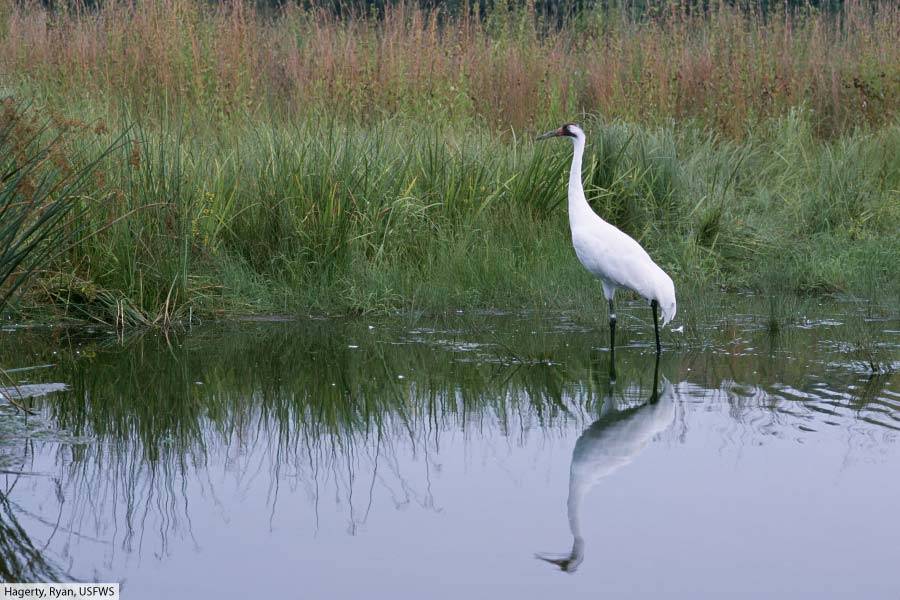
Type of animal: Bird
Order: Gruiformes
Family: Gruidae
Genus: Grus
Where found: All continents except South America and Antarctica
Cranes are tall wading birds with long necks and stilt-like legs. They inhabit marshes, wetlands, and plains in many parts of the world.
These omnivorous birds are highly social, and for most of the year live in large flocks. During the breeding season, however, mated pairs tend to be more independent as they build their nests and raise their chicks. All crane species are monogamous, often mating for life.
The majority of the fifteen living crane species are threatened (just four of the fifteen have the conservation status “Least Concern”). The whooping crane and grey crowned crane are endangered, while the Siberian crane is critically endangered.
While in flight, cranes hold their necks straight and their long legs trail behind them.
Most crane species are found in Africa and Asia. Some cranes are migratory, making annual migrations between breeding and overwintering areas.
Discover More With Active Wild
You can find out more about birds on this page: Birds – The Ultimate Guide
Discover different types of birds on this page: Types of Birds
Crocodile
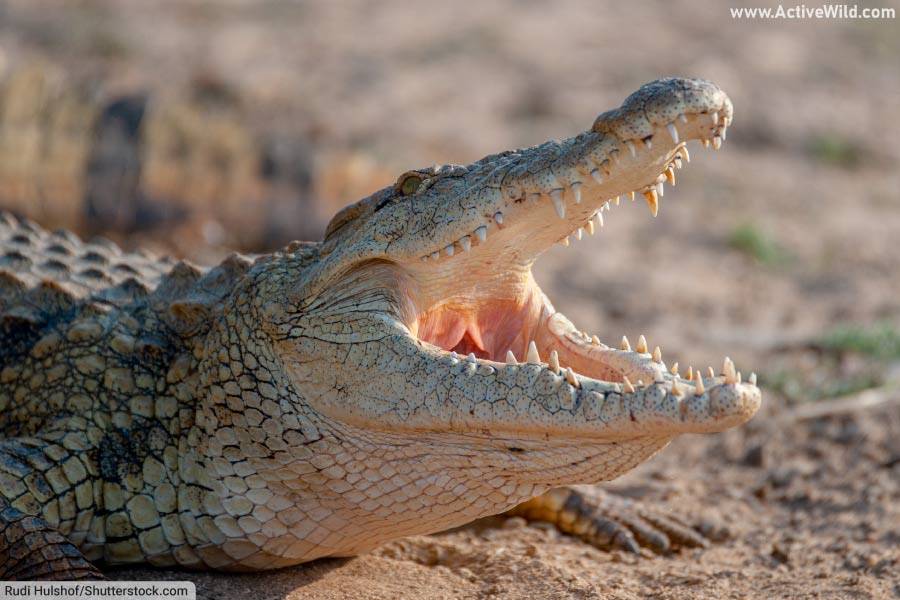
Type of animal: Reptile
Family: Crocodylidae
Where found: Africa, Asia, North America, South America, Australia
Crocodiles are reptiles belonging to the family Crocodylidae. Currently, 18 species of crocodile are recognized. (source)
Crocodiles are found in tropical and subtropical regions of Africa, Asia, the Americas, and Australia. They have long, powerful bodies, relatively short legs, a large head, and powerful jaws lined with sharp teeth. The largest species is the saltwater crocodile, which is also the world’s largest living reptile.
Crocodiles feed on a variety of animals, including fish, birds, mammals, and reptiles. They are often apex predators, playing an important role in their ecosystems by controlling numbers of prey animals.
Discover More With Active Wild
You can find out more about crocodiles in Africa on this page: Crocodiles In Africa
You can find out more about reptiles on this page: Reptiles – The Ultimate Guide
Crow

Type of animal: Birds
Order: Passeriformes
Family: Corvidae
Genus: Corvus
Where found: All continents except Antarctica
Crows are perching birds of genus Corvus. Crows are typically large, black birds. All are opportunistic omnivores that will feed on insects, eggs, small to medium vertebrates, fruits, seeds, carrion, and a wide range of other foods.
The usage of the name “crow” is often expanded: either to include any member of the genus Corvus, which also includes ravens and rooks, or to include any member of the family Corvidae, which additionally contains birds such as jays, magpies and nutcrackers.
Corvids (members of the family Corvidae) are among the most intelligent of all animals. Crows have been observed solving complex problems, using tools, and working as a team.
Crows are very similar to social mammals, living in close-knit family groups in which juveniles and adults participate in caring for the young who will remain with their parents for as long as six years. Crow families are fiercely protective of their territory and will hunt and forage together.
During winter, some crow species will gather into roosting groups that can reach hundreds of thousands of individuals. This is believed to provide warmth and protection.
Discover More With Active Wild
You can find out more about birds on this page: Birds – The Ultimate Guide
Discover different types of birds on this page: Types of Birds
Cuttlefish
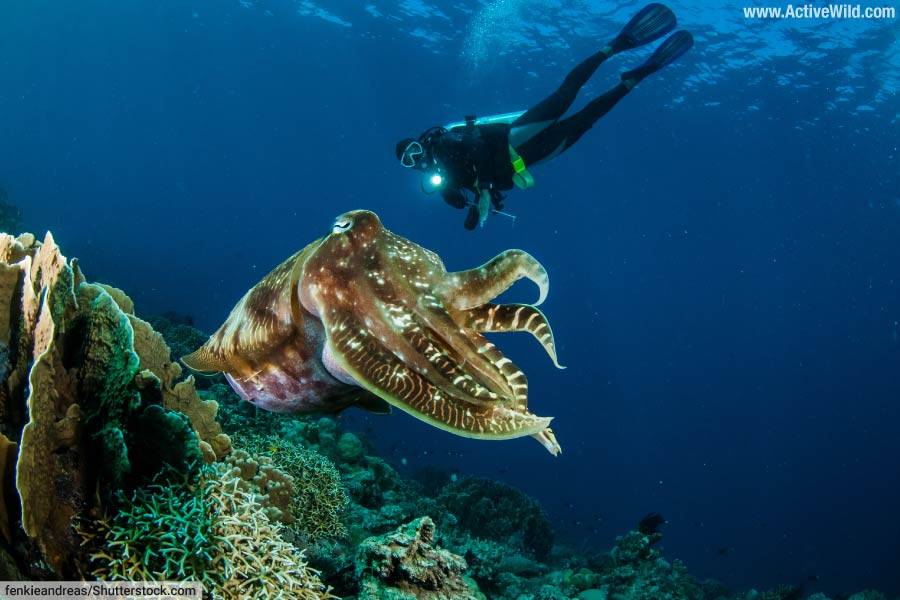
Type of animal: Fish
Order: Decapodiformes
Order: Sepiida
Where found: Oceans worldwide
Cuttlefish are cephalopod mollusks related to octopuses and squids. A distinguishing characteristic of a Cuttlefish’s body is the presence of an internal calcified shell called a cuttlebone. This shell does not provide protection, instead, it is filled with gas and used to control buoyancy.
Cuttlefish have unique, W-shaped pupils. Although unable to differentiate colors, their eyes are able to detect differences in contrast invisible to the human eye.
All 100-plus species of cuttlefish are found in marine habitats. They vary greatly in size, the smallest being just 2.5 cm / 1 in. in length; the largest (the Australian cuttlefish) reaching lengths of 50 cm / 20 in.
Discover More With Active Wild
Discover different types of mollusks on this page: Mollusks Examples
You can see more ocean animals on this page: Ocean Animals List with Pictures & Facts
Animals That Start With C: Conclusion
We hope that you’ve discovered some interesting animals with names beginning with C on this page.
You can discover more animals in our A to Z animals section by clicking on the letters below…
The post Animals That Start With C: List With Pictures & Interesting Facts appeared first on Active Wild.


























